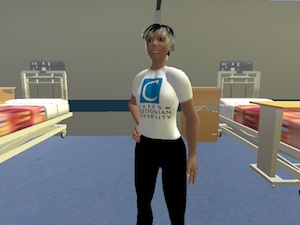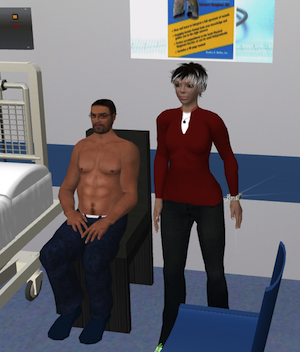 (This story appeared earlier today over at Metaverse Health).
(This story appeared earlier today over at Metaverse Health).
Coming from a nursing background myself, I’m always fascinated by the work going on in virtual environments in regards to nurse education. To some extent it’s a natural fit in that clinical simulation is a pivotal part of the education process for nurses anyway – using virtual environments is simply an extension of recognised practice.
Evelyn McElhinney (SL: Kali Pizzaro) is a Nurse Lecturer in the post-registration department of Glasgow Caledonian’s School of Health. She teaches a number of advanced practice modules including modules within the Nurse Practitioner pathway. She joined the university full time 3 years ago, and was a lecturer/practitioner working in an advanced practice role within the National Health Service prior to that and has worked in a number of acute care areas including anaesthesia. Evelyn also happens to be active in the use of Second Life in Nurse Practitioner training, so I caught up with her to discuss her work to date and some broader issues around collaboration.
Lowell: From a nursing education viewpoint, what are your key areas of professional interest / research focus?
Kali: Advancing practice, physical examination, clinical simulation, and recently the use of virtual worlds for Nurse Practitioner Education.
Lowell: When you say nurse practitioner, can you define that a little? I’m assuming you mean someone undergoing their undergraduate nursing education?
Kali: Ah no in the UK Nurse Practitioners are Registered Nurses who are advancing their practice. A nurse who takes a history, physical examination, diagnoses, prescribes and treats.
Lowell: Ok, that’s similar to Australia then. So are there particular advantages for using virtual worlds with more experienced nurses like practitioners rather than nursing students?
Kali: The advantages are that they need flexibility as they have competing demands on their time. So any medium that allows for extra practice in a time conducive to them is attractive. However, virtual worlds can do more than the usual virtual learning environment.
Lowell: When did Second Life become a consideration in your work?
Kali: I considered Second Life after seeing a project by one of my colleagues. I had know about it’s existence as the University had a project exploring it’s use for marketing. That was in March this year.
Lowell: Can you describe the work you’re doing in Second Life and how it links to the University’s CU There initiative?
Kali: I am trying to develop a virtual patient which will be used by Nurse Practitioner students to practice history taking. I have also embedded heart sounds into the avatar’s chest to enable the student to link the history to the heart sounds they hear. They must click on the correct anatomical position to hear the sounds. This work links to the CU There project as it fulfills the criteria for use of virtual worlds in education. By creating an AIML bot/bots the students have the flexibilty to practice at any time either as an individual or as a group. I plan to have a number of patients and to build on the sceanrios to create longer problem-based learning scenarios. The bot we use were developed by myself and the School technician Andy Whiteford aka AndyW Blackburn.
Lowell: So what level of work has been required to get the lab to this stage and how much more is involved to get it to where you’d like it to be?
Kali: The clinical skills lab was designed by the CU There team with guidance from the head academic in charge of the simulation lab . The build was done mainly by a computer student who is seconded to the team. There are plans to build an ITU for a scenario for 3rd year students. For my scenario it is mainly me thinking of ways to expand each scenario in alignment with the needs of my students.
Lowell: The most common feedback I’ve gotten from nursing academics is a skepticism on what virtual worlds offer that a well integrated curriculum with comprehensive leraning management tools can’t, that is, aside from the advantage of not needing to get students to a real-world simulation lab, are there other benefits of working in environments like this?
Kali: The immersive environment enables authentic scenarios to be developed. There is also the ability to offer syncrounous text and voice communication, as well as the ability to show the whole class videos etc. We can also simulate things that would be difficult in real life.
Lowell: Is there an example of that you currently use?
Kali: Not at the moment. However, for undegraduates it could be useful for them to be inside a heart or lung to understand the anatomy and physiology. It is also much more interactive than other VLE’s.
Lowell: I suppose that’s the crux of the challenge for nursing educators using virtual environments: convincing others that things have moved beyond the gimmicky, would you agree?
Kali: Yes, you need to show them something that is pedagologically sound, something they can see is useful.
Lowell: On pedagogy, what do you see as the key foundations in your work and in virtual environments more broadly?
 Kali: Constructivism and social constructivism are the key learning theories in my work. By linking history and heart and lung sounds to other parts of a clinical scenario, I am building on the students previous knowledge to create new knowledge. People in simulations tend to act the same as they do in real life. The ability to capture the text allows for reflection on the decision-making of this particular group.
Kali: Constructivism and social constructivism are the key learning theories in my work. By linking history and heart and lung sounds to other parts of a clinical scenario, I am building on the students previous knowledge to create new knowledge. People in simulations tend to act the same as they do in real life. The ability to capture the text allows for reflection on the decision-making of this particular group.
Lowell: What has the feedback been from students?
Kali: Positive- they can see they value. They feel they are in the sceanrio. However, it is early days. We have only had a few folk through as a pilot. We will be using it more in the next two semesters.
Lowell: Are there formalised evaluations planned on clinical skills training in Second Life ? Will there be comparative studies on those who used such tools versus those who didn’t and their subsequent outcomes?
Kali: Yes, a number of academics are evaluating their projects and one is plannning to compare in-world and out-of-world simulation. Some of these are through a University scheme, Caledonian Scholars.
Lowell: What’s your take on nursing research in virtual environments internationally? Is it fair to say it’s still very early days?
Kali: Yes, there are a number of good projects. However, it is still in it’s infancy. Simulation seems to be the most popular project.
Lowell: Is there any research completed or underway that has particularly interested you?
Kali: Many projects have impressed me. For example the work of John Miller at Tacoma, the Imperial College in London and the Ann Myers Medical Center. However, any project which is being used by students impresses me. With regards to research most are evaluations, however, my own university has just completed some research into student nurses’ clinical decision making (Dr. Jacqueline McCallum, Val Ness, Theresa Price, Andy Whiteford).
Lowell: Can you discuss what it’s found?
Kali: It’s still in publication, however a lot of what the students said was that they wanted to experience areas they had not been to, and that they also found the scenario exhausting. Interestingly, they did not do a single observation in an hours sceanrio in a busy surgical ward. They also did not know what to do with a patient who was demented and kept leaving the ward. I think they were too busy thinking what to do next, this was despite being prompted to do observations.
Lowell: You raise a very interesting point – perhaps virtual environments make a more natural stage for making errors as there isn’t the stress of the educator looking over their shoulder?
Kali: Maybe, although this sceanrio had educators involved. Although that is the beauty of simulation – make mistakes and no-one dies 😉
Lowell: For the nurse who has been working in either a hospital or community setting for five years or more, how do you make virtual environments like Second Life an appealing and logical extension of their professional development needs?
Kali: By making the scenarios authentic and as realistic as possible. Also they must be available at all times to ensure maximum flexibility. The student must see the value to be motivated to take part. If they are fun, then great.
Lowell: Do you think Second Life is at a stage of usability that it can achieve that now?
Kali: Not yet in the UK – it is still not widely know as a social tool. However, if it is introduced in education they may see more value, as it helps them to learn.
Lowell: On usability though – it’s still quite a learning curve to actually use, particularly for those not as net-savvy as others?
Kali: Well you could say that about any VLE, and it is really only arrows and clicking. Changing clothes is not mandatory for education. Well, not all education. I think most folks would get it in a short space of time with some guidance.
Lowell: Again specific to nursing, is there any great degree of collaboration going on internationally in regards to projects like these? How do you think nursing faculties could further improve collaboration?
Kali: We are exploring a couple of collaborations. I know Scott Deiner in New Zealand has collaborated with American colleges. However, there is the potential for major collaboration both nationally and internationally. Although you need to have a firm idea about what you want to collaborate on. Also there is still a little bit of folk finding their feet, so to share is still scary methinks.
Lowell: Do you think there’s the critical mass for organised collaborative structures such online journals or other formats for working together?
Kali: There could be, and the Virtual World Watch here has opened up avenues for collaboration by highlighting the people who are involved with virtual worlds, although there is a bit to go.
Lowell: So for a nursing academic looking to integrate virtual environments into their teaching or research, would you have any simple advice?
Kali: Make sure you think about what you want to use it for. Script the scenario and look around at other people’s work to find out what the virtual world is capable of. Also visit educational areas and talk to other academics or join a group. Make sure there is a strong pedagogical structure to your idea and show it to folks when you have something to show!! Seeing is believing.
——–
To view the publicly accessible clinical skills laboratory in Second Life, go here.
Speak Your Mind